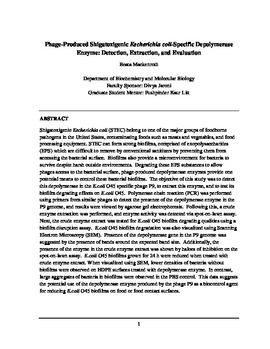| dc.contributor.author | Mackenroth, Beata | |
| dc.date.accessioned | 2019-02-09T14:24:23Z | |
| dc.date.available | 2019-02-09T14:24:23Z | |
| dc.date.issued | 2017-09-10 | |
| dc.identifier | oksd_mackenroth_HT_2017 | |
| dc.identifier.uri | https://hdl.handle.net/11244/317241 | |
| dc.description.abstract | Shigatoxigenic Escherichia coli (STEC) belong to one of the major groups of foodborne pathogens in the United States, contaminating foods such as meats and vegetables, and food processing equipment. STEC can form strong biofilms, comprised of exopolysaccharides (EPS) which are difficult to remove by conventional sanitizers by preventing them from accessing the bacterial surface. Biofilms also provide a microenvironment for bacteria to survive despite harsh outside environments. Degrading these EPS substances to allow phages access to the bacterial surface, phage-produced depolymerase enzymes provide one potential means to control these bacterial biofilms. The objective of this study was to detect this depolymerase in the E.coli O45 specific phage P9, to extract this enzyme, and to test its biofilm degrading effects on E.coli O45. Polymerase chain reaction (PCR) was performed using primers from similar phages to detect the presence of the depolymerase enzyme in the P9 genome, and results were viewed by agarose gel electrophoresis. Following this, a crude enzyme extraction was performed, and enzyme activity was detected via spot-on-lawn assay. Next, the crude enzyme extract was tested for E.coli O45 biofilm degrading qualities using a biofilm disruption assay. E.coli O45 biofilm degradation was also visualized using Scanning Electron Microscopy (SEM). Presence of the depolymerase gene in the P9 genome was suggested by the presence of bands around the expected band size. Additionally, the presence of the enzyme in the crude enzyme extract was shown by haloes of inhibition on the spot-on-lawn assay. E.coli O45 biofilms grown for 24 h were reduced when treated with crude enzyme extract. When visualized using SEM, lower densities of bacteria without biofilms were observed on HDPE surfaces treated with depolymerase enzyme. In contrast, large aggregates of bacteria in biofilms were observed in the PBS control. This data suggests the potential use of the depolymerase enzyme produced by the phage P9 as a biocontrol agent for reducing E.coli O45 biofilms on food or food contact surfaces. | |
| dc.format | application/pdf | |
| dc.language | en_US | |
| dc.rights | Copyright is held by the author who has granted the Oklahoma State University Library the non-exclusive right to share this material in its institutional repository. Contact Digital Library Services at lib-dls@okstate.edu or 405-744-9161 for the permission policy on the use, reproduction or distribution of this material. | |
| dc.title | Phage-produced Shigatoxigenic Escherichia coli-specific depolymerase enzyme: Detection, extraction, and evaluation | |
| osu.filename | oksd_mackenroth_HT_2017.pdf | |
| osu.accesstype | Open Access | |
| dc.type.genre | Honors Thesis | |
| dc.type.material | Text | |
| dc.contributor.director | Jaroni, Divya | |
| dc.contributor.facultyreader | Jadeja, Ravi | |
| thesis.degree.discipline | Animal Science | |
| thesis.degree.grantor | Oklahoma State University | |
